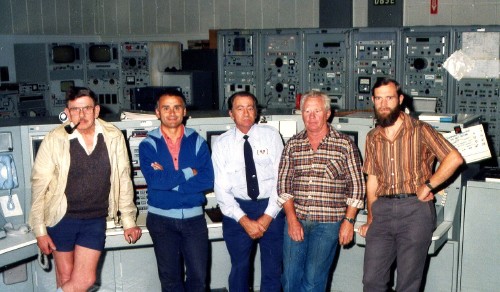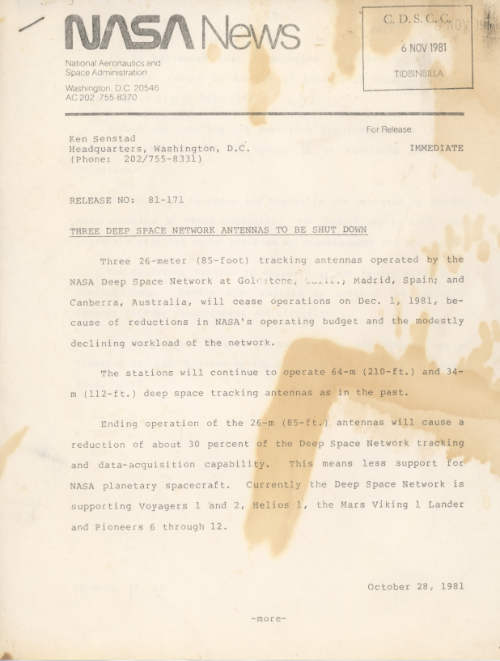by
Hamish Lindsay
|
23rd
November 1981: the last track of DSS44 in which Hamish Lindsay took
part.
From
left, Ken Staff, Power House; Tony Gerada, Shift Supervisor; Jeff Jennings, Security Guard; Brian Eagleton, RF and Receivers; Hamish Lindsay, RF and Servo.
Photo:
Hamish Lindsay. |
The first official announcement about Honeysuckle’s
closure was on Tuesday 27 October 1981.
|
This NASA press release, dated the next day, carries the sad news.
Page 1.
Page 2.
Preserved by Hamish Lindsay, scanned by Colin Mackellar. |
I had been on night shift when the phone rang at about 0745,
shortly before we were due to go home. It was Terry Dinn, the Security Guard,
to say that the Company Manager Jim Thompson was on site. Jim Thompson promptly
called a meeting of everyone in the Conference Room. After Geoff Ruck and his
crew arrived to start their shift at 0800, Jim opened the meeting with a letter
from the Department of Science. It was brutal and to the point:
All 26 metre sites were to be closed down at Goldstone,
Madrid and Canberra from 1 December 1981. The Department expect they may be
able to find jobs, probably with a demotion, though there was talk that even
Tidbinbilla and the whole DSN might be closed down.
Luckily the last threat did not eventuate, but the final days
were quite depressing as we all contemplated our futures.
The remaining staff continued tracking Helios and Pioneer 12,
with some Pulsars for the CSIRO thrown in, until Sunday 15 November when I had
my last shift as a Shift Supervisor on days. This time my memories are melancholy.
In the morning we tracked Helios 1 while on our commercial television we watched
STS-2, the second flight of the Shuttle end, as Joe Engle and Richard Truly
brought Columbia down to land. Then Chef Reno excelled himself and gave us a
superb lunch to make us feel better – Minestrone soup, Roast Chicken and
Veal washed down with a nice white wine, followed by apple pie and cream to
finish. All for the normal price of 90 cents!
In the afternoon while tracking Pioneer 12 orbiting Venus we
had the cricket on the television – the First Test with Australia playing
Pakistan at the WACA in Perth, with Kim Hughes and Bruce Laird batting for us
all afternoon (we won by 286 runs). But we could also hear the ominous sounds
of furniture and equipment being carried out of the building to waiting trucks.
Despite the gourmet lunch and homely television there was an uncomfortable feeling
of foreboding and gloom.
Obviously the end was near for HSK/DSS44.
My last track at Honeysuckle Creek was on 23 November
with Tony Gerada and Brian Eagleton on night shift for a Helios 1 pass. Uncharacteristically
we erased the whole HA48 predicts and Track had to send the floaters again.
Then it was just a quiet, nominal pass. As it was the night shift from midnight
to 0800, we only had Ken Staff in the powerhouse and Jeff Jennings down in the
guard hut; we were the only people on the site. It was a subdued team that said
farewell to each other and drove down the mountain that morning.
Then came the final track – the very last track of all
– on 2 December 1981.
DSS44 supported pass 1279 of Pioneer 12, orbiting the planet
Venus. Pioneer 12 was the Pioneer-Venus Orbiter, a companion for the Pioneer
13 Venus Multiprobe which we had tracked into the Venusian atmosphere on 9 December
1978. Over a decade later Pioneer 12 burned up in the Venusian atmosphere on
8 October 1992 when it ran out of fuel.
Paul Mullen writes: “The track was not that remarkable as
it went off smoothly. After it was over, I had the feeling that we were let
down – but progress had to take place. I was on the desk at the time and
I had asked Tom Reid’s permission to play the Last Post.”
After Paul broke track and punched the switch to send the antenna
to the stow position for the last time ever, Station Director Tom Reid and Shift
Supervisor Tony Gerada stood by the operations console while Paul played the
Last Post over the network and DSS 44 Honeysuckle Creek was no more.
The data and voice links from Honeysuckle Creek operations over
the Deadman’s Hill passive repeater to Tidbinbilla and the world beyond,
fell silent for the first time in 14 years.
After the last track, Honeysuckle Creek Tracking Station, alias HSK and
DSS44, designed and built specially for the Apollo Moon landings, was completely
shut down. A small team remained to dismantle and remove the equipment, the
cables were pulled out, and we walked out the door, leaving just an empty building.
During December the electrical power was turned off, the Caterpillar
diesels put to bed and prepared for sale. The deserted buildings became dark
and fell silent. The antenna servos no longer whined into the night. The clients
of the best restaurant for kangaroos in the district were left to dine on the
grass in peace.
Honeysuckle Creek simply faded away – there were no farewells,
no speeches, no parties, no wakes. Nobody cared.
The last of us left who had put money into farewell presents
for departing staff members for all those years gave ourselves inscribed silver
mugs as a memory. The next time Honeysuckle Creek made the newspapers, only
the local ones now, it was pictures and descriptions of the results of vandal
attacks.
During its short but glorious life, Honeysuckle Creek had distinguished
itself as a top station around the world in two completely different spheres
as a Manned Space Flight Station attached to the Mission Control Center in Houston,
Texas, and then as a Deep Space Station attached to the Jet Propulsion Laboratory
in Pasadena, California.
Vale Honeysuckle Creek.

